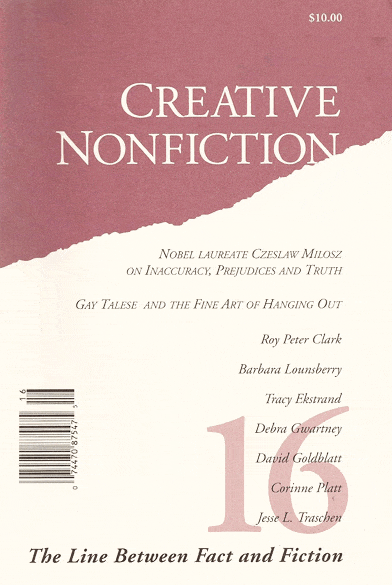Issue 16 / 2001

16 / The Line Between Fact and Fiction
Featuring Nobel Laureate Czeslaw Milosz, a profile of Gay Talese, and journalist Roy Peter Clark.
This issue explores the methods in which nonfiction writers utilize the fiction writer’s toolbox without crossing the blurry divide between reality and imagination. As journalist Roy Peter Clark writes in the titular essay, “Subjectivity and selectivity are necessary and inevitable in journalism. If you gather ten facts but wind up using nine, subjectivity sets in.”
Also in Creative Nonfiction #16: Debra Gwartney hunts for her runaway teenage daughter; Jesse L. Traschen transforms from professional dancer to businessman; Dov Siporinand navigates the psychological perils of slaughterhouse work; Nobel Laureate Czeslaw Milosz discusses inaccuracy, prejudices and truth; and Barbara Lounsberry interviews Gay Talese.
Already a subscriber?
Read this issue nowTable of Contents
FROM THE EDITOR: Creative Nonfiction: The Driving Force
Take a look at the advertisement (inside the front cover) for the Walter V. Shipley Best Essay Award, which offers $10,000 for the best essay written about the subject of diversity.The Line Between Fact and Fiction
Journalists should report the truth. Who would deny it? But such a statement does not get us far enough, for it fails to distinguish nonfiction from other forms of expression. Novelists can reveal great truths about the human condition, and so can poets, film makers and painters.Milosz’s ABCs
The past is inaccurate, because we cannot determine how it was in fact, no matter how hard we try. We must rely on people’s memory, which is treacherous, because memory is constantly juggling and revising the data of experience.Tenderloin: A Memoir
The best the cop can do is take my daughters name and add her to a national database of runaways. From across the counter in this dank San Francisco police station, he offers this, as if typing names of missing children rounds them up in some satisfying way, as if that alone should be a comfort and I should leave here with my mind at ease.Roger’s Brew
“Malted barley is a process, not a thing,” Roger admonishes … again. The grain room in the basement of the Smuggler’s Brewpub smells like a horse stable. Bags of barley stacked in rows 5 feet high fill the tiny room.Two Mississippi
On the morning of June 24, 1998, Dr. Sander Diamond, a professor of history at Keuka College and a man of intense enthusiasms, sat in his home office adjacent to the campus.Dream of a Four-Chambered Heart
In the beginning there is, of course, the pregnancy: nausea, denial and finally the pee test, the undeniable color blue. There are two phone calls to a clinic in Boston: “I need to schedule an abortion.”The Hickeys on Sally Palermo’s Neck: Some Thoughts on Beauty and the Creative Life
Sam, my grandfather, was a womanizer. After 12 years of marriage, he finally left my grandmother to marry a younger woman.From Tights to Ties
The dance resumé is the epitome of utility. Name, address that week, companies you’ve performed with, how many calories you can survive on and your age minus five years. The resumé should be typed, although boldface, bullets and fancy fonts won’t matter a damn.The Day After That
By lunchtime, Daniel Judah Sklar has taught playwriting to four junior high school classes at the Emily Dickinson School on West 96th Street. That’s part of his routine. So are the three flights of stairs he trudges up and down throughout the day.Looking for Mr. Clean: An All-Purpose Memoir
You are nuts, I said to myself as I picked up the kitchen phone. You should be taken away and locked in a clean white room, I said as I dialed the number.Finding Home
Today my father and I begin to prepare for the Passover Seder. He instructs me in the preparation of the turkey, how to wash it and prepare the grill.Gay Talese and the Fine Art of Hanging Out
At precisely 4 p.m. on December 28, 1983, I knocked on the door of Gay Talese’s five-story town house at 109 East 61st in New York City.
